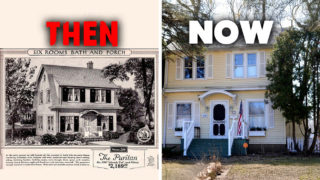The kitchen has long been the heart of the home—a space filled with warmth, creativity, and countless family gatherings. But as design trends evolve, some beloved kitchen features have slowly faded from modern homes, leaving behind a sense of nostalgia. In this article, we’ll take a look back at 11 classic kitchen elements that have quietly disappeared, each one bringing its own unique charm and character to the kitchens of the past. From vintage appliances to cozy design touches, these features remind us of a simpler time when the kitchen was more than just a place to cook—it was a place to connect.
11. The Dining Nook

Dining nooks, also known as breakfast nooks, were a cozy staple in mid-20th-century homes. These built-in seating areas, often tucked into a kitchen corner, offered a casual, inviting spot for family meals, with storage hidden beneath the benches for added functionality. Modeled after café seating, they created a warm space for connection over breakfast and lunch. While open floor plans have largely replaced them, dining nooks are still adored in vintage and cottage-style homes, keeping that nostalgic charm alive.
10. Tiled Countertops

Back in the 1940s and ’50s, tiled countertops were all the rage, loved for their durability and wide range of colors and patterns. The tiles made cleaning surfaces easier, but grout lines could be a hassle. Eventually, materials like laminate took over with their seamless designs and easier upkeep. Yet, these original tiled counters still grace many historic homes, a lasting reminder of mid-century design.
9. Linoleum Flooring

Linoleum flooring, invented in 1860 from natural materials like linseed oil and wood flour, was both eco-friendly and durable. Known for its colorful patterns, linoleum brightened up countless kitchens. But as vinyl flooring took over, linoleum began to fade from the spotlight. Today, though, its charm and environmental benefits still capture the hearts of retro enthusiasts.
8. Hoosier Cabinets

Hoosier cabinets revolutionized kitchens in the early 1900s, providing compact organization for baking supplies. Named after the Hoosier Manufacturing Company, they often featured built-in flour sifters, spice racks, and even pullout work surfaces. As kitchens evolved to built-in cabinetry, these free-standing units lost ground, yet they remain beloved collectibles for their practicality and old-world charm.
7. Push Button Stoves

Push-button stoves were the height of modern kitchen tech in the 1950s, offering a streamlined look with buttons to control burners and ovens. These futuristic stoves brought a cleaner aesthetic compared to traditional knobs. Over time, however, technology shifted to more intuitive controls, making push-button stoves a memorable piece of kitchen history.
6. Pull-Down Ironing Boards

Convenient and space-saving, pull-down ironing boards were common in kitchens and laundry rooms in the mid-20th century. Built right into the wall, they could be pulled down when needed and tucked away when not, keeping efficiency at the forefront. Today, they’re a rare find, mostly in vintage kitchens, and offer a sweet nod to a time when every square inch of space counted.
5. Wall-Mounted Can Openers

From the 1950s to the ’70s, wall-mounted can openers were a practical and counter-saving solution, allowing for quick meal prep access. As electric can openers became popular, these mounted versions became less necessary. Today, they’re more likely to be found in antique shops, treasured for their simplicity and throwback vibes.
4. Built-In Flour Sifters

Built-in flour sifters were an early 20th-century kitchen must-have, letting bakers sift flour directly into mixing bowls without the extra mess. As baking habits shifted and pre-sifted flour became more accessible, these handy features faded away. Now, they’re more of a vintage curiosity, admired for their practicality in a time when baking from scratch was an everyday ritual.
3. The Meat Safe

Before refrigeration, meat safes were a kitchen essential. Made of wood or metal, with mesh or perforated panels, they allowed air to circulate while keeping pests out. Placed in cool spots, they helped keep food fresh longer. With the rise of modern refrigeration, meat safes became obsolete, though they remain an interesting piece of culinary history.
2. Rolling Pin Drawers

Once a baker’s dream, the rolling pin drawer was designed to fit rolling pins perfectly, making them easy to store and access without clutter. As kitchens evolved toward more versatile storage solutions, these dedicated drawers disappeared. Antique cabinets with rolling pin drawers are now valued for their old-fashioned charm and nod to a time when specialized storage was key.
1. Central Vacuum Cleaners

Considered a modern luxury in the 1950s and ’60s, central vacuum systems featured wall outlets in each room, offering a quiet and powerful alternative to traditional vacuums. Early models even used water-based collection to reduce allergens. But as portable vacuums became more efficient and affordable, central systems began to fade. They still pop up in some older homes, standing as a quiet reminder of mid-century convenience.




























